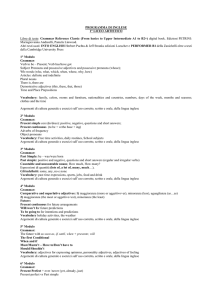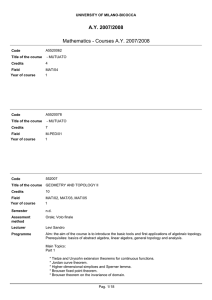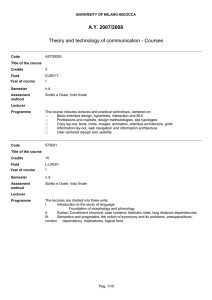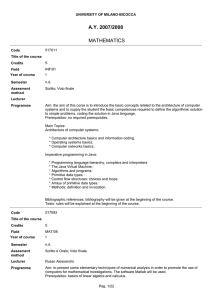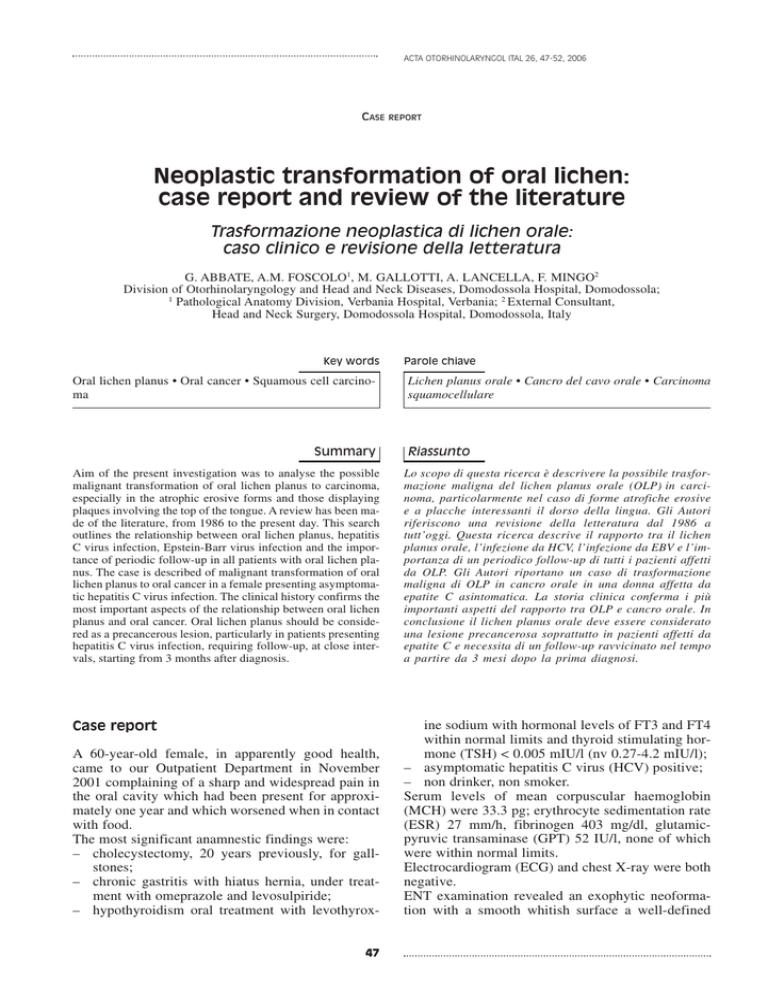
ACTA OTORHINOLARYNGOL ITAL 26, 47-52, 2006
CASE
REPORT
Neoplastic transformation of oral lichen:
case report and review of the literature
Trasformazione neoplastica di lichen orale:
caso clinico e revisione della letteratura
G. ABBATE, A.M. FOSCOLO1, M. GALLOTTI, A. LANCELLA, F. MINGO2
Division of Otorhinolaryngology and Head and Neck Diseases, Domodossola Hospital, Domodossola;
1
Pathological Anatomy Division, Verbania Hospital, Verbania; 2 External Consultant,
Head and Neck Surgery, Domodossola Hospital, Domodossola, Italy
Key words
Oral lichen planus • Oral cancer • Squamous cell carcinoma
Summary
Parole chiave
Lichen planus orale • Cancro del cavo orale • Carcinoma
squamocellulare
Riassunto
Aim of the present investigation was to analyse the possible
malignant transformation of oral lichen planus to carcinoma,
especially in the atrophic erosive forms and those displaying
plaques involving the top of the tongue. A review has been made of the literature, from 1986 to the present day. This search
outlines the relationship between oral lichen planus, hepatitis
C virus infection, Epstein-Barr virus infection and the importance of periodic follow-up in all patients with oral lichen planus. The case is described of malignant transformation of oral
lichen planus to oral cancer in a female presenting asymptomatic hepatitis C virus infection. The clinical history confirms the
most important aspects of the relationship between oral lichen
planus and oral cancer. Oral lichen planus should be considered as a precancerous lesion, particularly in patients presenting
hepatitis C virus infection, requiring follow-up, at close intervals, starting from 3 months after diagnosis.
Lo scopo di questa ricerca è descrivere la possibile trasformazione maligna del lichen planus orale (OLP) in carcinoma, particolarmente nel caso di forme atrofiche erosive
e a placche interessanti il dorso della lingua. Gli Autori
riferiscono una revisione della letteratura dal 1986 a
tutt’oggi. Questa ricerca descrive il rapporto tra il lichen
planus orale, l’infezione da HCV, l’infezione da EBV e l’importanza di un periodico follow-up di tutti i pazienti affetti
da OLP. Gli Autori riportano un caso di trasformazione
maligna di OLP in cancro orale in una donna affetta da
epatite C asintomatica. La storia clinica conferma i più
importanti aspetti del rapporto tra OLP e cancro orale. In
conclusione il lichen planus orale deve essere considerato
una lesione precancerosa soprattutto in pazienti affetti da
epatite C e necessita di un follow-up ravvicinato nel tempo
a partire da 3 mesi dopo la prima diagnosi.
Case report
ine sodium with hormonal levels of FT3 and FT4
within normal limits and thyroid stimulating hormone (TSH) < 0.005 mIU/l (nv 0.27-4.2 mIU/l);
– asymptomatic hepatitis C virus (HCV) positive;
– non drinker, non smoker.
Serum levels of mean corpuscular haemoglobin
(MCH) were 33.3 pg; erythrocyte sedimentation rate
(ESR) 27 mm/h, fibrinogen 403 mg/dl, glutamicpyruvic transaminase (GPT) 52 IU/l, none of which
were within normal limits.
Electrocardiogram (ECG) and chest X-ray were both
negative.
ENT examination revealed an exophytic neoformation with a smooth whitish surface a well-defined
A 60-year-old female, in apparently good health,
came to our Outpatient Department in November
2001 complaining of a sharp and widespread pain in
the oral cavity which had been present for approximately one year and which worsened when in contact
with food.
The most significant anamnestic findings were:
– cholecystectomy, 20 years previously, for gallstones;
– chronic gastritis with hiatus hernia, under treatment with omeprazole and levosulpiride;
– hypothyroidism oral treatment with levothyrox47
G. ABBATE, ET AL.
sessile lesion, approximately 5 mm in diameter, in
correspondence to the mucosa of the right cheek.
Results of the histological examination of the neoformation, removed under local anaesthesia on 28.11.2001,
referred to a diagnosis of an inflammatory polyp with
inflammation of the lichen planus type (Fig. 1).
Fig. 3. Lichenoid dysplasia. Epithelial thecae display
structural disorders and cytological abnormalities e.g. increased nucleo-plasmic ratio anisokaryosis, nuclear hyperchromatism, irregular nuclear margin (Biopsy 01484I-02, H&E, 250X).
Fig. 1. Inflammation of lichen planus type. Lymphocyte
infiltration occupies connective stroma even covering
basal layer of epithelium (arrow) (Biopsy 06464-I-01, H&E,
40X).
At follow-up 4 months later, a whitish plaque adhering to the oral mucosa was found in correspondence
to the previous lesion, the surface of the lesion was
irregular but was not painful.
A biopsy specimen was collected on 13.3.2002. The
histological diagnosis was keratosic epithelial hyperplasia, resulting from focally ulcerated leucoplakia
(Fig. 2) associated with lichenoid dysplasia (Fig. 3).
Fig. 4. Squamous cell carcinoma. Area showing marked
degree of differentiation (Biopsy 03166-I-02, H&E, 100X).
The patient was programmed for follow-up after 3
months: at the beginning of June the lesion was ulcerated, slightly raised with granulating surfaces and
well-defined, hard, margins. The histological diagnosis on 5.6.2002 was: fragments of well-differentiated
G1 squamous cell carcinoma (Fig. 4) with moderately differentiated areas G2 ulcerated and infiltrating;
lichen was also present.
Review of the literature
Fig. 2. Ulcerated area. No evidence of important cytological abnormalities (Biopsy 00467-I-03, H&E,100X).
Lichen planus is a chronic inflammatory disease occurring in adult age 1 2. It is relatively common 3-8, of48
NEOPLASTIC TRANSFORMATION OF ORAL LICHEN
ten recurrent, itchy 9 10 not contagious 11 and involves
the skin and mucosa 7 11-14.
The mouth is involved in only ~1/3rd cases whilst in
another 1/3rd lesions are both oral and cutaneous 7 12.
The incidence, in the general population, is approximately 1%, affecting all races and both sexes, a
greater frequency being observed in females, 70% of
whom between 30 and 60 years of age 6 11 14 15.
Familial cases Are rare. An association has been observed with HLA-A3, A11, A26, A28, B3, B5, B7,
B8, DR1, DRW9 6 11 14.
The aetiopathogenesis remains unknown 6 7 11 16, even
if recent data have shown that immunological mechanisms may play a role 6: it would appear to be an
anomalous immune response in which the epithelial
cells are not recognized, secondary to mutations in
the superficial antigens 4.
It would thus be a graft versus host reaction in which
the cell-mediated reaction involves cytotoxic lymphocytes versus the impaired basal keratinocytes 2 11 14.
In keeping with the hypothesis of an autoimmune aetiopathogenesis is the frequent association of lichen
planus with autoimmune diseases, such as primary
biliary cirrhosis, chronic active hepatitis, ulcerative
colitis, myasthenia gravis, thymoma 8 11.
As demonstrated in the literature, and the focal point
of numerous studies, are also the associations of lichen
planus with several viruses, such as, for example, human papilloma virus (HPV 16 and HPV 18) 17 18, Epstein Barr virus (EBV) 19, human Herpes virus 6
(HHV-6) 20 and hepatitis C virus (HCV) 9 21-25.
The syndrome of Grinspan has been described with a
symptomatological triade – arterial hypertension, diabete mellitus, erosive oral lichen planus with malignant transformation 26.
Cases of lichen planus have been reported after the
use of certain pharmaceutical agents such as antimalaria drugs, gold salts, penicillamine, diuretics,
thiazide, β-blocking agents, non-steroidal anti-inflammatory drugs (NSAIDs), quinidine, angiotensin
converting enzyme inhibitors 9, streptomycin,
methyldopa, phenothiazine 27.
Clinically, oral lichen planus (OLP) may manifest in
various forms:
– reticular (the most frequent, with small isolated
or confluent small white papules or, network of
white lines, the so-called Wickham’s striae).
– Erosive and ulcerated (painful lesions of various
sizes).
– Atrophic (less common, often resulting from the
erosive-ulcerative form with reddish lesions with
a rough surface and irregular, poorly defined.
margins).
– Hypertrophic (rare whitish well-circumscribed
raised plaque similar to leucoplakia).
– Bullous (very rare, pemphgoid, para-neoplastic).
Very rare pigmentous, due to local overproduction of
49
melanine during the acute phase of the disease 6 8 10-12 27 28.
Mucosal lesions, which are multiple, generally have a
symmetrical distribution 6 8 12 28, particularly on the mucosa of the cheeks, in correspondence to the molars,
and on the mucosa of the tongue, less frequently on the
mucosa of the lips (lichenous cheilitis 11 15 27) and on the
gums (the atrophic and erosive forms localized on the
gums manifest as a desquamative gengivitis 8), more
rarely on the palate and floor of the mouth 8.
The lichenous papula can be recognized by the semeiological Bizzozzero sign: rubbing the lesion induces transformation into a bleeding papula on account of micro-haemorrhage at the dermo-epidermic
junction due to fragility of the capillaries 11. Furthermore, the initial lichen lesion may develop after rubbing (reactive isomorphism the so-called Köbner
phenomenon 8 11).
Oral lichen planus is often asymptomatic 6 28 or may
give rise to a burning or painful feeling 8 11, irritation
following contact with certain foods, an unpleasant
sensation of a dry mouth 8.
The erosive and boil-like forms tend to be painful 8.
The clinical history includes phases of remission and
exacerbations 8.
From a histological point of view, OLP is characterised by oedema and dense lymphohistiocyte infiltration, localized in the papillary derma, which penetrates and detatches the basal layer which becomes
unrecognizable.
Within the papillary derma, hyaline Pas positive bodies (Civette bodies) can be found containing immunoglobulins, primarily IgM, evident at direct immunofluorescence, and cytoids bodies which are degenerated keratinocytes. Furthermore, it is possible
to find orthokeratosic hyperkeratosis, focal hypergranulosis, irregular acanthosis, vacuolar degeneration of the basal layer, acantholysis of the basal cells,
loss of the hemidesmosomes responsible for the
basal cells becoming adhered 6 10 11 27-30.
Treatment consists in short-term topical fluorurated
and systemic corticosteroids 11 28 31.
In some cases, lichen planus responds to griseofulvin
per os, which is administered until complete disappearance of the lesion 28.
Photochemotherapy PUVA, retinoids per os, and
anxiolytics are also used 11.
Much controversy still exists and studies are being
focused on the possible transformation of OLP to
epidermoid carcinoma 5 6 12 16 21 29 31-39.
OLP is considered a precancerous lesion 32 34 35, an
unrecognised leucoplakia 12; a greater malignant potential has been recognized for lichen ruber planus 12,
the erosive or erythematous 5 form, the ulcerative
form 31 35, atrophic, erosive form and the plaques on
the back of the tongue 21 27, when a smoker is involved 36. In the latter case, the doubt remains as to
whether the OLP is intrinsecally precancerous or pre-
G. ABBATE, ET AL.
disposes to malignant transformation mediated by
external factors 16.
Furthermore, it should not be forgotten that the erosive and atrophic forms may resemble the appearance
of a carcinoma 6.
In most cases, malignant transformation to carcinoma in situ (28.5%) and in microinvasive carcinoma
(30-38%) is observed, less frequently stage I and II
carcinoma 38 39.
Oral cancer-correlated OLP predisposes to the development of multiple primary metachronous tumours
of the oral cavity and of lymph node metastases.
Therefore, ORL examinations are recommended
every month, for the first 6-9 months after diagnosis,
and, thereafter, 3 times a year 39.
Results
This clinical case presenting the typical aspects
found in the literature was, in our opinion, worthwhile describing, namely:
– lesions of the oral mucosa which can be classified
as lichen planus – slightly symptomatic, bilateral
symetrical, on the mucosa of the cheeks;
– ulcerated form of OLP transformed, in approximately seven months, to squamous carcinoma;
– asymptomatic HCV positivity.
A review of the literature led us to the following considerations:
– follow-up of OLP should be programmed for 6
months to 15 years 5 8 14 32 39-46 with cases of malignant transformation 40 years after the initial diagnosis of OLP 12;
– the percentage of OLP cases that transform to
epidermoid carcinoma varies from 0.4% to
3.7% 5 8 14 31 32 40-44;
– the site most frequently involved in the malignant
transformation is the back of the tongue 3 15 21 24 36 40-44;
– the malignant transformation does not always occur in the presence of the well-known risk factors
of oral cancer, i.e., smoking and alcohol 49;
– the OLP form that most frequently transforms
into carcinoma is the erosive symptomatic
form 15,17,23,27,29,30,31,38,48 while the atrophic form
is probably a predisposing factor 44;
– there is no general agreement as to whether females are more likely to present malignant transformation of an OLP, than males;
– patients with oral and cutaneous lichen planus
are at greater risk of developing oral cancer from
OLP 13 36;
OLP may be considered an extrahepatic manifestation of HCV infection 23-25 and, in these cases, more
frequently undergoes malignant transformation 24.
Discussion and conclusions
It is mandatory, in patients with oral lesions of the
lichen planus type, even if asymptomatic or barely
symptomatic, to programme scrupulous long-term
follow-up.
Considering the rapid malignant transformation observed in the case described (3 months after lichen
planus with lichenoid dysplasia and 3 months after
lichenoid dysplasia and ulcerated infiltrating cancer
G1-G2) suggests the need for histopathological observations at more frequent intervals (at least every 3
months) from the time of the first diagnosis.
Even more scrupulous attention is necessary in those
cases presenting concomitant skin invasion of lichen,
HCV infection, HBV infection, autoimmune diseases.
References
1
2
3
4
5
6
Bouquot JE, Gorlin RJ. Leucoplakia, lichen planus, anal
other oral keratoses in 23,616 white Americans over the
age of 35 years. Oral Surg Oral Med Oral Pathol
1986;61:373-81.
Brabant P, Bossuyt M. Oral lichen planus. Acta Stomatol
Belg 1990;87:233-9.
Camisa C, Hamaty FG, Gay JD. Squamous cell carcinoma
of the tongue arising in lichen planus: a case report and review of the literature. Cutis 1998;62:175-8.
Edward PC, Kelsch R. Oral lichen planus: clinical presentation and management. J Can Dent Assoc 2002;68:494-9.
Eisen D. The clinical features, malignant potential and systemic association of oral lichen planus: a study on 723 patients. J Am Acad Dermatol 2002;46:207-14.
Collins SL. Carcinoma squamoso di cavità orale, orofaringe e pareti faringee. In: Ballenger JJ. Patologia otorinola-
7
8
9
10
11
12
50
ringoiatrica. Prima edizione Italiana. Milan: ABA Scientifica 1993. p. 346-7.
Tay AB. A 5-year survey of oral biopsies in an oral surgical unit in Singapore: 1993-1997. Ann Acad Med Singapore 1999;28:665-71.
Laskaris G. Color atlas of oral disease. Stuttgart - New
York: Georg Thieme Verlag; 1994.
Katta R. Lichen planus. Am Fam Physician 2000;61:331924, 3327-8.
Sapuppo A, Lanza G. Lichen Ruber Planus In: Lanza G.
Anatomia patologica sistematica. 2a Edn. Vol. 1. Padova:
Piccin 1985. p. 974-5.
Leigheb G. Testo e Atlante di Dermatologia. Pavia: Edizioni Medico Scientifiche 1995. Ch. 20. p. 207-13.
De Vincentiis M, Gallo A, Minni A, Turchetta R, Acquaviva G. Le precancerosi del cavo orale. In: de Campora E. I
Tumori del Cavo Orale. V Convegno Internazionale, Roma
– Isola Tiberina, November 20-21, 1992.
NEOPLASTIC TRANSFORMATION OF ORAL LICHEN
13
14
15
16
17
18
19
20
21
22
23
24
25
26
27
28
29
Massa MC, Greaney V, Kron T, Armin A. Malignant transformation of oral lichen planus: case report and review of
the literature. Cutis 1990;45:45-7.
Ognjenovic M, Karelovic D, Cindro VV, Tadin I. Oral
lichen planus and HLA A. Coll Antropol 1998;22:89-92.
Moncarz V, Ulmansky M, Lustmann J. Lichen planus: exploring its malignant potential. J Am Dent Assoc
1993;124:102-8.
Kilpi A, Rich AM, Reade PC, Konttinen YT. Studies of the
inflammatory process and malignant potential of oral mucosal lichen planus. Aust Dent J 1996;41:87-90.
Gross G, Gund Lach K, Reichart PA. Virus infections and
tumors of the oral mucose. Symposium of the “Arbeitsskreis Oralpathologie und Oral Medizin” and the “Arbeitsgemeinschaft Dermatologische Infektiologie der
Deutschen Dermatologischen Gesellschaft”, Rostock, July
6-7, 2001. Eur J Med Res 2001;6:440-58.
Wen S, Tsuji T, Li X, Mizugaki Y, Hayatsu Y, Shinozaki F.
Detection and analysis of human papillomavirus 16 and 18
homologous DNA sequences in oral lesions. Anticancer Res
1997;17:307-11.
Sand LP, Jalouli J, Larsson PA, Hirsch JM. Prevalence of
Epstein-Barr virus in oral squamous cell carcinoma, oral
lichen planus, and normal oral mucosa. Oral Surg Oral
Med Oral Pathol Oral Radiol Endod 2002;93:586-92.
Yadav M, Arivananthan M, Chandrashekran A, Tan BS,
Hashim BY. Human herpes virus-6 (HHV-6) DNA and
virus-encoded antigen in oral lesions. J Oral Pathol Med
1997;26:393-401.
Lo Muzio L, Mignogna MD, Favia G, Procaccini M, Testa
NF, Bucci E. The possible association between oral lichen
planus and oral squamous cell carcinoma: a clinical evaluation on 14 cases and a review of the literature. Oral Oncol
1998;34:239-46.
Nagao Y, Sata M, Noguchi S, Suzuki H, Mizokami M,
Kameyama T, et al. GB virus infection in patients with oral
cancer and oral lichen planus. J Oral Pathos Med
1997;26:138-41.
Patrick L. Hepatitis C: epidemiology and review of complementary/alternative medicine treatments. Altern Med Rev
1999;4:220-38.
Porter SR, Lodi G, Chandler K, Kumar N. Development of
squamous cell carcinoma in hepatitis C virus-associated
lichen planus. Oral Oncol 1997;33:58-9.
Roy K, Bagg J. Hepatitis C virus and oral disease: a critical review. Oral Dis 1999;5:270-7.
Colella G, Itro A, Corvo G. A case of a carcinoma arising
in lichen planus in a subject with diabetes mellitus and arterial hypertension (Grinspan’s syndrome). Minerva Stomatol 1992;41:417-20.
Cecil. Trattato di Medicina Interna. XVI Edn. Padova: Piccin; 1985. Vol. 2. p. 3204.
Fred MS, Mc Connel MD. Stomatite aftosa recidivante. In:
Hurst JW. Medicina clinica per il medico pratico. 2a edn.
Italiana a cura di Dioguardi N. Milan: Masson 1991; Ch.
677. p. 1874-5.
Bruno G, Alessandrini M, Russo S, D’Erme G, Nucci R,
Calabretta F. Malignant degeneration of oral lichen planus:
our clinical experience and review of literature. Ann Otorrinolaringol Ibero Am 2002;29:349-57.
51
30
31
32
33
34
35
36
37
38
39
40
41
42
43
44
45
46
47
48
Duffey DC, Eversole LR, Abemayor E. Oral lichen planus
and its association with squamous cell carcinoma: an update on pathogenesis and treatment implications. Laryngoscope 1996;106:357-62.
Tovaru S, Ben Slama L, Boisnic S. Oral lichen planus and
cancer. Apropos of 2 cases. Rev Stomatol Chir Maxillofac
1993;94:46-50.
Bromwich M. Retrospective study of progression of oral
premalignant lesion to squamous cell carcinoma: a South
Wales experience. J Otolaryngol 2002;31:150-6.
Burruano F, Tortorici S. Oral lichen planus: a possibile precancerous lesion. Stomatol Mediterr 1989;9:241-5.
Eisenberg E. Lichen planus and oral cancer: is there a connection between the two? J Am Dent Assoc 1992;123:104-8.
Faraci RP, Schour L, Graykowski EA. Squamous cell carcinoma of the oral cavity – chronic oral ulcerative disease as
a possible etiologic factor. J Surg Oncol 1975;7:21-6.
Gawkrodger DJ, Stephenson TJ, Thomas SE. Squamous
cell carcinoma complicating lichen planus: a clinico-pathological study on three cases. Dermatology 1994;188:36-9.
Kats RW, Brahim JS, Travis WD. Oral squamous cell carcinoma arising in a patient with long-standing lichen
planus: a case report. Oral Surg Oral Med Oral Pathol
1990;70:282-5.
Mignogna MD, Lo Muzio L, Lo Rosso L, Fedele S, Ruoppo E, Bucci E. Clinical guidelines in early detection of oral
squamous cell carcinoma arising in oral lichen planus: a 5year experience. Oral Oncol 2001;37:262-7.
Mignogna MD, Lo Russo L, Fedele S, Ruoppo E, Califano
L, Lo Muzio L. Clinical behaviour of malignant transforming oral lichen planus. Eur J Surg Oncol 2002;28:838-43.
Barnard NA, Scully C, Eveson JW, Cunningham S, Porter
SR. Oral cancer development in patients with oral lichen
planus. J Oral Pathol Med 1993;22:421-4.
Dunsche A, Harle F. Precancer stages of the oral mucosa:
a review. Laryngorhinootologie 2000;79:423-7.
Kaplan B, Barnes L. Oral lichen planus and squamous carcinoma. Case report and update of the literature. Arch Otolaryngol 1985;111:543-7.
Markopoulos AK, Antoniades D, Papanayotou P, Trigonidis
G. Malignant potential of oral lichen planus; a follow-up
study of 326 patients. Oral Oncol 1997;33:263-9.
Murti PR, Daftary DK, Bhonsle RB, Gupta PC, Mehta FS,
Pindborg JJ. Malignant potential of oral lichen planus: observations in 722 patients from India. J Oral Pathol
1986;15:71-7.
Pang JF. Several non-traumatic examination methods for
oral leukoplakia lichen planus and carcinoma. Zhonghua
Kou Qiang Yi Xue Za Zhi 1990;25:282-4, 318.
Sigurgeirsson B, Lindelof B. Lichen planus and malignancy. An epidemiologic study of 2071 patients and a review of
the literature. Arch Dermatol 1991;127:1684-8.
Haya Fernandez MC, Bagan Sebastian JV, Basterra Alegrira J, Lloria De Miguel E. Prevalence of oral lichen
planus and oral leucoplakia in 112 patients with oral
squamous cell carcinoma. Acta Otorrinolaringol Esp
2001;52:239-43.
Kaplan BR. Oral lichen planus and squamous carcinoma:
case report and update of the literature. R I Dent J
1991;24:5-9, 11-4.
G. ABBATE, ET AL.
49
Deeb ZE, Fox LA, De Fries HO. The association of chronic inflammatory disease in lichen planus with cancer of the
oral cavity. Am J Otolaryngol 1989;10:314-6.
50
■ Received: September 16, 2004
Accepted: Aprile 6, 2005
■ Address for correspondence: Dr. G. Abbate, Via Alcide De
Gasperi, 14, 28845 Domodossola, Italy. Fax: +39 0324
491301/491411
52
Marder MZ, Deesen KC. Transformation of oral lichen
planus to squamous cell carcinoma: a literature review and
report of case. J Am Dent Assoc 1982;105:55-60.


